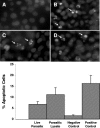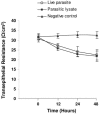Blastocystis ratti induces contact-independent apoptosis, F-actin rearrangement, and barrier function disruption in IEC-6 cells
- PMID: 16790785
- PMCID: PMC1489721
- DOI: 10.1128/IAI.00328-06
Blastocystis ratti induces contact-independent apoptosis, F-actin rearrangement, and barrier function disruption in IEC-6 cells
Abstract
Blastocystis is an enteric protozoan purportedly associated with numerous clinical cases of diarrhea, flatulence, vomiting, and other gastrointestinal symptoms. Despite new knowledge of Blastocystis cell biology, genetic diversity, and epidemiology, its pathogenic potential remains controversial. Numerous clinical and epidemiological studies either implicate or exonerate the parasite as a cause of intestinal disease. Therefore, the aim of this study was to investigate the pathogenic potential of Blastocystis by studying the interactions of Blastocystis ratti WR1, an isolate of zoonotic potential, with a nontransformed rat intestinal epithelial cell line, IEC-6. Here, we report that B. ratti WR1 induces apoptosis in IEC-6 cells in a contact-independent manner. Furthermore, we found that B. ratti WR1 rearranges F-actin distribution, decreases transepithelial resistance, and increases epithelial permeability in IEC-6 cell monolayers. In addition, we found that the effects of B. ratti on transepithelial electrical resistance and epithelial permeability were significantly abrogated by treatment with metronidazole, an antiprotozoal drug. Our results suggest for the first time that Blastocystis-induced apoptosis in host cells and altered epithelial barrier function might play an important role in the pathogenesis of Blastocystis infections and that metronidazole has therapeutic potential in alleviating symptoms associated with Blastocystis.
Figures








Similar articles
-
Blastocystis ratti contains cysteine proteases that mediate interleukin-8 response from human intestinal epithelial cells in an NF-kappaB-dependent manner.Eukaryot Cell. 2008 Mar;7(3):435-43. doi: 10.1128/EC.00371-07. Epub 2007 Dec 21. Eukaryot Cell. 2008. PMID: 18156286 Free PMC article.
-
Statin pleiotropy prevents rho kinase-mediated intestinal epithelial barrier compromise induced by Blastocystis cysteine proteases.Cell Microbiol. 2012 Sep;14(9):1474-84. doi: 10.1111/j.1462-5822.2012.01814.x. Epub 2012 May 31. Cell Microbiol. 2012. PMID: 22587300
-
Strain-dependent induction of human enterocyte apoptosis by blastocystis disrupts epithelial barrier and ZO-1 organization in a caspase 3- and 9-dependent manner.Biomed Res Int. 2014;2014:209163. doi: 10.1155/2014/209163. Epub 2014 Apr 14. Biomed Res Int. 2014. PMID: 24822183 Free PMC article.
-
Blastocystis in humans and animals: new insights using modern methodologies.Vet Parasitol. 2004 Dec 9;126(1-2):121-44. doi: 10.1016/j.vetpar.2004.09.017. Vet Parasitol. 2004. PMID: 15567582 Review.
-
Blastocystis, an unrecognized parasite: an overview of pathogenesis and diagnosis.Ther Adv Infect Dis. 2013 Oct;1(5):167-78. doi: 10.1177/2049936113504754. Ther Adv Infect Dis. 2013. PMID: 25165551 Free PMC article. Review.
Cited by
-
Genetic variability of Blastocystis sp. isolated from symptomatic and asymptomatic individuals in Iran.Parasitol Res. 2012 Dec;111(6):2311-5. doi: 10.1007/s00436-012-3085-5. Epub 2012 Sep 5. Parasitol Res. 2012. PMID: 22948205
-
Distribution and phylogenetic analysis of Blastocystis sp. subtypes isolated from IBD patients and healthy individuals in Iran.Eur J Clin Microbiol Infect Dis. 2017 Dec;36(12):2335-2342. doi: 10.1007/s10096-017-3065-x. Epub 2017 Jul 25. Eur J Clin Microbiol Infect Dis. 2017. PMID: 28741097
-
Advances in the axenic isolation methods of Blastocystis sp. and their applications.Parasitology. 2024 Feb;151(2):125-134. doi: 10.1017/S0031182023001300. Epub 2023 Dec 13. Parasitology. 2024. PMID: 38087868 Free PMC article. Review.
-
Mechanisms and modeling of wound repair in the intestinal epithelium.Tissue Barriers. 2023 Apr 3;11(2):2087454. doi: 10.1080/21688370.2022.2087454. Epub 2022 Jun 11. Tissue Barriers. 2023. PMID: 35695206 Free PMC article. Review.
-
Pathophysiological variability of different genotypes of human Blastocystis hominis Egyptian isolates in experimentally infected rats.Parasitol Res. 2008 Apr;102(5):853-60. doi: 10.1007/s00436-007-0833-z. Epub 2008 Jan 11. Parasitol Res. 2008. PMID: 18193282
References
-
- Alexeieff, A. 1911. Sur la nature des formations dites kystes de Trichomonas intestinalis. C. R. Soc. Biol. 71:296-298.
-
- Ashford, R. W., and E. A. Atkinson. 1992. Epidemiology of Blastocystis hominis infection in Papua New Guinea: age-prevalence and associations with other parasites. Ann. Trop. Med. Parasitol. 86:129-136. - PubMed
-
- Bjarnason, I., A. MacPherson, and D. Hollander. 1995. Intestinal permeability: an overview. Gastroenterology 108:1566-1581. - PubMed
-
- Bojarski, C., K. Bendfeldt, A. H. Gitter, J. Mankertz, M. Fromm, S. Wagner, E. O. Riecken, and J. D. Schulzke. 2000. Apoptosis and intestinal barrier function. Ann. N. Y. Acad. Sci. 915:270-274. - PubMed
Publication types
MeSH terms
Substances
LinkOut - more resources
Full Text Sources
Other Literature Sources

